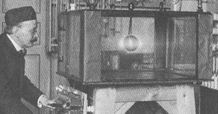|
There remained one puzzle. Polar explorers had reported that the aurora was
extremely rare near the magnetic poles themselves. Why? A few of Birkeland's experiments indeed produced a ring of light with a dark center, but in general he only got a polar patch of light, covering the magnetic poles of the terrella. Birkeland's younger friend, the mathematician Carl Stoermer, analyzed the motion of the electrons mathematically and even computed many of their orbits, a tough task in the pre-computer days around 1907-10. He found no compelling reason why electrons entering the field from far away would avoid the poles.
Stoermer died in 1957, still frustrated by this problem. The answer only came
when satellites began probing the distant magnetosphere. They showed
conclusively that the aurora did not in general come from the Sun or from
distant space, but originated in the Earth's own magnetosphere. On the other
hand, the electrons of the polar rain, which apparently did come from the Sun,
were indeed found in patches surrounding the magnetic poles, exactly like the
patches of light Birkeland observed on his terrella.
Further Reading:
"A Brief History of Magnetospheric Physics before the Spaceflight Era," Reviews of Geophysics, 27, 103-114, 1989.
|
